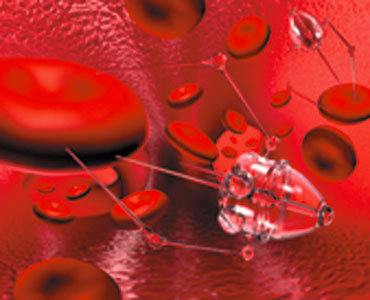Writer’s Choice: Connections between visual, science explored
When visual culture is mentioned, molecules, materials science and technology do not often come to mind. But exploring the possible intersections between the visual and science is the focus of a conference organized by the Visual Culture Center at UW–Madison. “Visualizing Science,” to be held Feb. 7–8, is the latest in the center’s series of public conferences that explore visual culture, part of an ongoing collaboration among scholars from sciences, arts and humanities. The conference will take up issues of visuality and visual technologies in the sciences.

A rendering of a nanobot shown here with a proboscis stuck into a blood platelet.
The conference includes a public lecture, workshop, research colloquium and exhibition. All events are free and open to the public, but advanced registration is required for the research colloquium on Friday, Feb. 8.
The conference begins at 5:30 p.m. on Thursday, Feb. 7, with a lecture by Michael Lynch, professor and director of graduate studies in science and technology studies at Cornell University. Lynch’s lecture, “Drawing Attention to Nano: Fantastic Realism and Other Modes of Visual Impression Management in Nanotechnology,” will take place in Room L140 of the Chazen Museum of Art.
Nanotechnology has produced many popular images, from fantastic nanobots placed in realistic nanoscapes to crude atomic drawings that resemble children’s fingerpaintings. The images are controversial because they highlight the ethical tensions involved in simulating invisible realms by placing them in classic realistic compositions.
The research colloquium will be held from 9 a.m.–12:10 p.m. Friday, Feb. 8, in the Pyle Center auditorium. It will feature short presentations and discussions from UW–Madison faculty, graduate students and other guests on how issues of audience and communication shape the way science is visualized and the roles of culture, technology and subjectivity.
Colloquium participants include: Dominique Brossard, assistant professor, journalism and mass communication; Laurie Beth Clark, professor, art; Wendy Crone, associate professor, engineering physics; Greta Zenner, Materials Research Science and Engineering Center, Meghan Doherty, Ph.D. candidate, art history; Joan Fujimura, professor, sociology; Steve Hilyard, associate professor, art; Judith Houck, assistant professor, medical history and bioethics; Michael Lynch, professor and director of Science and Technology Studies at Cornell University; Daniel Kleinman, director, Holtz Center for Science and Technology Studies; Patty Loew, associate professor, life sciences communication; Lynn Nyhart, professor, history of science; Shiela Reaves, professor, life sciences communication; Dietram Scheufele, professor, life sciences communication; and Tom Still, Wisconsin Technology Council.
The afternoon workshop, “Topical Contextures and Objectivity,” is also at the Pyle Center. It will include examples and exercises in which participants will explore how visualization is featured in scientific communication, demonstration and argument.
The workshop, from 1:15–3:15 p.m., is for faculty and graduate students and will be facilitated by Lynch. Seating is limited and advanced registration is required. Email the Visual Culture Center to register and to access required readings.
The conference concludes that afternoon with the viewing of an exhibition and a talk by the curators in the Kohler Art Library, 800 University Ave., from 3:30–4 p.m. Guest co-curators and Ph.D. students in art history will discuss “The Scientist’s Eye: Dialogues between Art and Science.” The exhibition features artist and rare books from the Kohler Art Library and Special Collections at Memorial Library.
“Visualizing Science” is co-sponsored by the College of Agricultural and Life Sciences, the Eye Research Institute, the Robert F. and Jean E. Holtz Center for Science and Technology Studies, and the departments of Art, Art History, Medical History and Bioethics, and Sociology and is made possible by a grant from the Anonymous Fund.
The Visual Culture Center turns its sights April 9–11 to “Interdisciplinarity and the University Art Museum.” The conference will include public lectures, a workshop and a research colloquium. For more information on these and other events, visit the the Visual Culture Center.
The Visual Culture Center was established in 2002 and is a leader in the emerging field of visual culture studies. The center supports cutting-edge creative production and interdisciplinary research, programming and community outreach activities. Visual Culture encourages connections and collaborations among the arts, humanities, social sciences and sciences.
